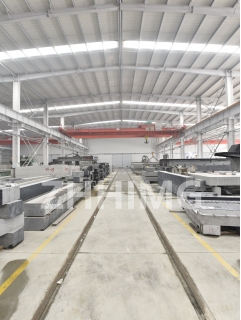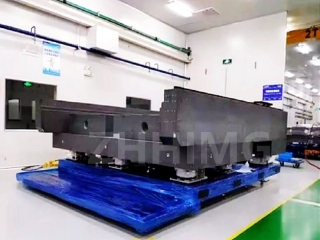In cutting-edge fields such as semiconductor manufacturing and optical instrument assembly, the pursuit of sub-micron or even nanometer-level positioning accuracy by multi-axis precision worktables is endless. High-density granite (with a density of ≥3100kg/m³) is becoming a key material for optimizing the performance of workbenches due to its unique physical properties. The following is an analysis of its irreplaceable advantages from four core dimensions.
1. Outstanding stability: A "natural barrier" to suppress vibration interference
When a multi-axis worktable is in high-speed motion (with a linear speed exceeding 500mm/s) or in multi-axis linkage, complex vibrations are prone to occur. The internal mineral particles of high-density granite are closely interlocked, with a natural frequency as low as 10-20Hz, and can absorb more than 90% of the external vibration energy. In the semiconductor chip packaging process, it can control the workbench displacement error within ±0.5μm, avoiding wire offset or chip damage caused by vibration. Compared with traditional cast iron materials, the vibration attenuation rate of granite is three times faster, significantly improving the consistency of processing.

2. Thermal stability: The "Stabilizing anchor" against temperature fluctuations
In a precision processing environment, a temperature change of 0.1℃ can cause a material deformation of 0.1μm/m. The coefficient of thermal expansion of high-density granite is only (4-8) ×10⁻⁶/℃, which is approximately 1/6 of that of aluminum alloy. In high-precision scenarios such as optical lens grinding, even if the workshop temperature fluctuates by ±2℃, the granite base can still maintain the micron-level positioning accuracy of the key components of the workbench, ensuring that the lens curvature error is less than 0.01D, far exceeding the industry standard.
3. Ultra-high rigidity: The "Solid Foundation Stone" for bearing heavy loads
Multi-axis worktables are often equipped with heavy components such as laser heads and probe arrays (with a single-axis load exceeding 200kg). The compressive strength of high-density granite is ≥200MPa, and it can withstand a uniform load of over 1000kg/m² without permanent deformation. After a certain aerospace enterprise adopted this material, when its five-axis worktable carried a processing load of 500kg, the Z-axis verticality error only increased by 0.3μm, effectively ensuring the processing accuracy of complex curved surfaces.
4. Long-lasting durability: Reduce the total life cycle cost
The Mohs hardness of granite reaches 6 to 7, and its wear resistance is more than five times that of ordinary steel. In a 3C product production line that operates for an average of 16 hours per day, the granite base can achieve maintenance-free operation for 8 to 10 years, while the cast iron base shows wear on the guide rail contact surface (depth > 5μm) after 3 years. In addition, its chemical inertness enables it to maintain a surface roughness of Ra≤0.2μm in acidic and alkaline environments, continuously providing a stable installation reference for precision components such as grating rulers and linear motors.
Conclusion: High-density Granite - The "Hidden Champion" of Precision Manufacturing
From nanoscale positioning to heavy-duty processing, high-density granite is reshaping the technical standards of multi-axis precision worktables with its unparalleled comprehensive performance. For enterprises that pursue ultimate precision and reliability, choosing high-quality granite bases (such as ZHHIMG® products certified by the ISO three systems) is not only a guarantee for current production but also a strategic investment in future process upgrades.
Post time: Jun-09-2025

